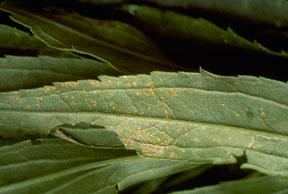COLEOSPORIUM NEEDLE RUST OF PINE ( Coleosporium asterum )
Over 20 species of Coleosporium
cause rust diseases on pine in the United
States. Coleosporium asterum is the best
known of the group and infects 2- and 3-needle pines including Austrian, red,
and Scots. This fungus may
be found acoss the continental United States. Alternate hosts for the rust include
aster, goldenrod, and some other Compositae sp. These needle rusts
complete their life cycles in about one year. Although we rarely find much of
this pathogen in New York State, it may ocassionally become severe. As with many
rusts, the life cycle is complicated and entails the production of several kinds
of spores and fruiting bodies.
Fig. 1. Aecia on needles of Austrian pine
The disease cycle may begin on pine in later summer or early Autumn when it is infected by basidiospores produced on the alternate host. The fungus grows into and overwinters in the needles, and yellow spots develop on them the following spring. Fruiting bodies, called spermagonia, develop beneath these spots initially, but then other white, tongue-like fruiting bodies, called aecia, grow from these spots as well. When they burst, they release bright orange spores that will reinfect the alternate host.
On the alternate host,
uredinial pustules form which produce more spores to infect that host. This cycle
repeats, and innoculum increases over the summer.Then in late summer, telia develop
on the margins of the uredinia. Basidiospores which develop from the telia, will
infect pine needles. A few species of Coleosporium will survive for more than
one year as mycelium in the living tissue of the pine host. C. asterum
is one such rust sometimes producing aecia for 2-3 summers. 
Some methods of preventing this disease are to plant trees on slopes, leave adequate space between trees when planting, and keep weeds under control all to encourage good air circulation around the base of the trees, even at maturity. Another option is to control the alternate hosts with mowing before August each year, or eradicate them with herbicides. A fungicide may also be used to treat this disease where it becomes a problem.
Fig. 2 Uredinial pustules on goldenrod (an alternate host)
Return to Pest Menu